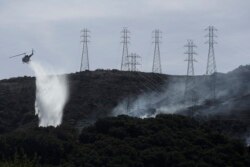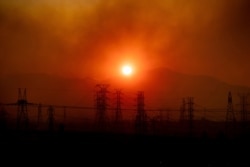LOS ANGELES — The lights are back on through most of California, where two million people had their power cut last week in a precautionary effort to prevent wildfires. A heightened fire risk has left power companies racing to upgrade transmission systems, which sometimes spark the blazes.
The power was deliberately cut through large swathes of Northern California, where Pacific Gas & Electric left 700,000 businesses and homes temporarily in the dark, some from October 9-12. 24,000 customers had their power cut by Southern California Edison, and for most, it was back within 24 hours.
“A large part of the problem is climate change,” said Severin Borenstein, a professor at the Haas Business School at UC Berkeley and faculty director of the school’s Energy Institute.
“Electricity lines have been starting fires for a century, but generally those fires were pretty small,” he said. “What’s changed, and we saw in a dramatic and horrible way in Paradise, California last year,” he said, “is that the same sort of electric line failure can now cause a massive conflagration, which is that case killed 85 people.”
Pacific Gas & Electric, the company whose equipment sparked the so-called Camp Fire, the deadliest in the state’s history, has again been criticized for its widespread precautionary cuts, both for the way they were carried out and for how it communicated with customers.
California Governor Gavin Newsom has urged a $100 rebate for affected homeowners, and $250 for small businesses.
Utility companies are upgrading infrastructure, and an expanding their system of cameras and weather sensors provide real-time data, supplemented by satellite images from the space agency NASA, and human analysis. They don’t catch all the problems, however.
“In the last five years, about 50 to 60% of the fires that have started involving our system have been due to things flying into our lines,” said Don Daigler, director of business resiliency for Southern California Edison. “It’s not necessarily a failure of our system,” he said. “It could be palm fronds, it could be other vegetation, it could be a critter (animal),” or a weather balloon, he added.
Power providers are working to reduce the risk by trimming trees and upgrading from bare transmission lines to insulated cables.
They’re also rethinking procedures for precautionary power cuts, said UC Berkeley’s Borenstein. One proposal would create a committee on precautionary cuts that “would include utility executives, but it would also include public safety officials, and it would also include regulators and possibly politicians.” Now, he says, utilities have an incentive to reduce their risk as much as possible, and the cost of the power cuts is borne by consumers.
Borenstein says regulatory changes could also promote better decision-making. California’s utility companies are now liable for damages when their equipment sparks fires, even when they’re not negligent, and he believes that should be changed.
Distributed power production could also reduce the need for transmission lines in high risk areas allow “local production of renewable electricity, for example distributed solar and battery energy storage. Those are also very important technologies for avoiding wildfires,” said Jack Brouwer, an engineering professor at the University of California, Irvine. The director of the university’s National Fuel Cell Research Center, Brouwer says new fuel cell technology, similar to that being introduced in cars, can create more local generation. The university’s medical center gets 30 percent of its power from fuel cells.
These experts say there is no single solution to the increased fire risk, but there are ways to manage the risk, which appears to be increasing in California and many other places.








